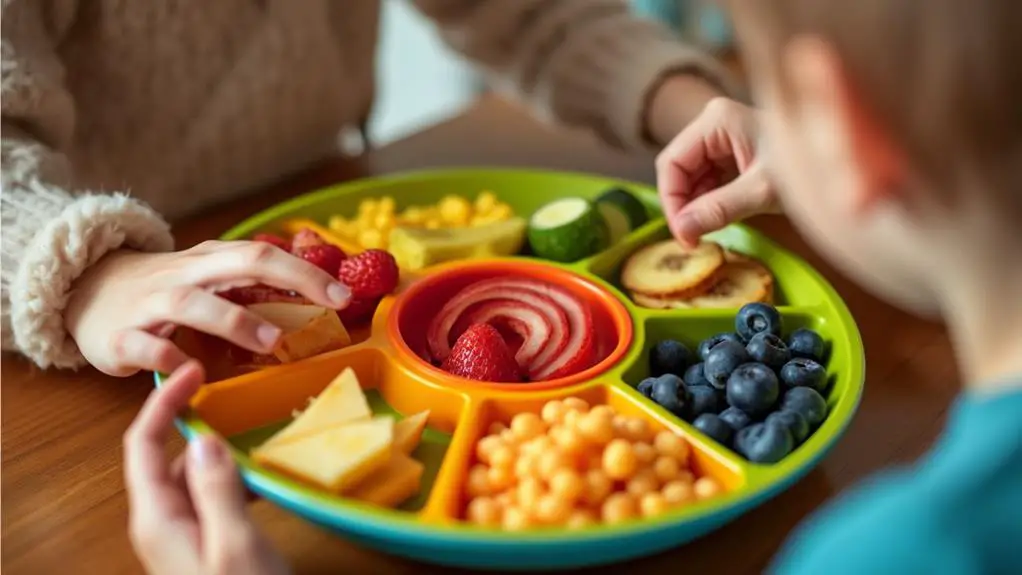Introducing New Foods to Picky Eaters: Strategies for Parents
To introduce new foods to picky eaters, create a relaxed mealtime environment without pressure. Involve your child in meal planning and preparation to spark curiosity. Use creative presentations, like fun shapes or colorful arrangements, to make new foods visually appealing. Introduce small portions of unfamiliar items alongside favorites, and be patient—it can take 10-15 exposures for acceptance. Give foods playful names to increase interest, and celebrate small victories when your child explores new tastes. Remember, consistency and a positive attitude are key. With these strategies, you'll be better equipped to navigate the challenges of expanding your child's palate.
Key Takeaways
- Create a positive mealtime environment with relaxed conversation and no pressure to eat.
- Present new foods alongside familiar favorites in small, visually appealing portions.
- Involve children in meal planning and preparation to increase interest and familiarity.
- Use creative naming and presentation strategies to make new foods more appealing.
- Consistently expose children to new foods, understanding that 10-15 exposures may be necessary for acceptance.
Understanding Picky Eating Behavior
Picky eating is a common challenge that many parents face, especially during their child's toddler years. It's a normal part of development, affecting up to half of preschoolers as they assert their independence.
As a parent, you'll notice your child's food preferences can change daily, making meal planning tricky. Don't be discouraged if your little one rejects new foods; it often takes 10-15 exposures before acceptance.
Patience and persistence are key when introducing new foods to picky eaters. To increase the likelihood of success, involve your child in food preparation and offer a variety of healthy options consistently.
Creating a Positive Mealtime Environment
You'll find that creating a relaxed family atmosphere at mealtimes can considerably impact your child's willingness to try new foods.
Focus on engaging conversations and shared experiences rather than pressuring your picky eater to finish their plate.
Additionally, presenting food in playful, creative ways can spark curiosity and make the dining experience more enjoyable for everyone.
Relaxed Family Atmosphere
Tranquility at the dinner table can be a game-changer when introducing new foods to picky eaters. By creating a relaxed mealtime atmosphere, you'll encourage open communication and reduce anxiety, increasing your child's willingness to try new foods.
Engage in discussions during meals, sharing interesting stories or asking icebreaker questions to enhance the dining experience.
Consider casual settings like picnics or family-style meals to promote togetherness and shift focus away from the food itself. Avoid negative comments or pressure about eating, as this helps foster a positive relationship with eating.
Instead, celebrate small victories when your child explores new foods, even if it's just a tiny bite. This approach builds confidence and encourages curiosity rather than resistance.
Playful Food Presentation
Visual appeal can transform a picky eater's perception of new foods. By using playful food presentation techniques, you'll encourage your child to try new foods with enthusiasm. Create colorful arrangements that inspire them to "eat the rainbow," and use cookie cutters to shape fruits and vegetables into fun designs. Engage your child by involving them in meal preparation, fostering curiosity about new ingredients.
| Presentation Technique | Benefits |
|---|---|
| Creative names | Increases excitement |
| Themed meals | Enhances curiosity |
| Bite-sized portions | Reduces intimidation |
Offer small, visually appealing portions of new foods to minimize pressure. Remember, the goal is to make mealtime enjoyable and exploratory. By transforming meals into playful experiences, you'll create positive associations with diverse foods, helping your child develop a more adventurous palate over time.
Gradual Food Introduction Techniques

Gradual food introduction techniques can be a game-changer for parents dealing with picky eaters. To help your child overcome picky eating, introduce new foods alongside familiar favorites. Remember, it may take 10-15 attempts before your child accepts a new food.
Present bite-sized portions to reduce intimidation and encourage tasting without pressure. Gradually increase exposure by incorporating new foods during snacks or meals, ensuring they're visible and accessible.
Use a step-by-step approach: start by presenting the new food, model interaction, and reinforce participation with praise and preferred foods. Create a positive mealtime atmosphere, avoiding negative comments and focusing on engagement.
This approach fosters a willingness to try new foods. By consistently applying these techniques, you'll help your child expand their palate and develop healthier eating habits over time.
Involving Children in Meal Preparation
While gradual food introduction can be effective, another powerful strategy is involving children in meal preparation. Studies show that when you engage kids in cooking activities, they're more likely to try new foods. By allowing them to explore textures, flavors, and cooking methods, you'll enhance their willingness to taste unfamiliar dishes.
| Benefits of Involving Children | Activities | Skills Developed |
|---|---|---|
| Increased food familiarity | Meal planning | Decision-making |
| Enhanced willingness to taste | Cooking | Basic culinary skills |
| Sense of ownership | Food presentation | Creativity |
Encourage your children to help with meal planning, fostering interest in diverse food options. Teach basic cooking skills through fun, interactive activities to boost their confidence. Creative food presentation during meal preparation can make meals more appealing, encouraging them to try new foods. By involving children in these processes, you'll empower them to make healthier food choices.
Creative Presentation and Naming Strategies

Creativity can be a game-changer when introducing new foods to picky eaters. Try using imaginative names like "dinosaur broccoli" or "rainbow carrots" to spark curiosity.
Present meals in fun shapes or use cookie cutters to enhance visual appeal. Incorporate colorful vegetables to encourage "eating the rainbow," fostering excitement about different flavors and textures.
Tell stories about food origins or share fun facts to capture your child's attention and encourage tasting. Themed meals, such as "taco night," allow kids to customize their plates, empowering them to choose what they want to try.
This creative presentation approach makes mealtime more engaging and less intimidating for picky eaters. By combining these strategies, you'll create a positive dining experience that encourages your child to explore new foods willingly and enthusiastically.
Consistent Exposure and Patience
Beyond creative presentations, the key to expanding a picky eater's palate lies in consistent exposure and patience. Research shows that children may need 10-15 exposures to new foods before accepting them. Don't give up if your child rejects a food initially; instead, reintroduce it gradually over time.
Avoid pressuring or nagging during mealtimes, as this can create negative associations. Instead, model eating the new foods yourself and offer them consistently in a relaxed environment. Remember, selective eating is often a normal phase, and your pediatrician can provide reassurance about your child's growth.
| Exposure | Result |
|---|---|
| 1-5 | Rejection |
| 6-10 | Curiosity |
| 11-15 | Tasting |
| 16-20 | Acceptance |
| 21+ | Enjoyment |
Consistent exposure and patience are vital in helping your child develop a diverse palate and healthy eating habits.
Conclusion
You've learned several strategies to help your picky eater expand their palate. While it's often believed that children will simply "grow out of" picky eating, research suggests that proactive parental involvement is key. By consistently applying these techniques, you're not just addressing current mealtime challenges, but potentially shaping your child's long-term relationship with food. Remember, it's a journey that requires patience and persistence. Keep at it, and you'll likely see positive changes over time.






